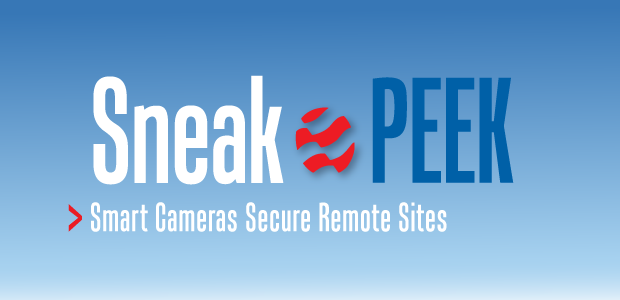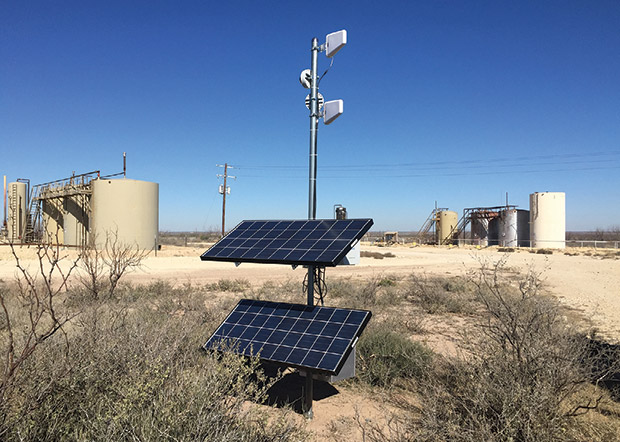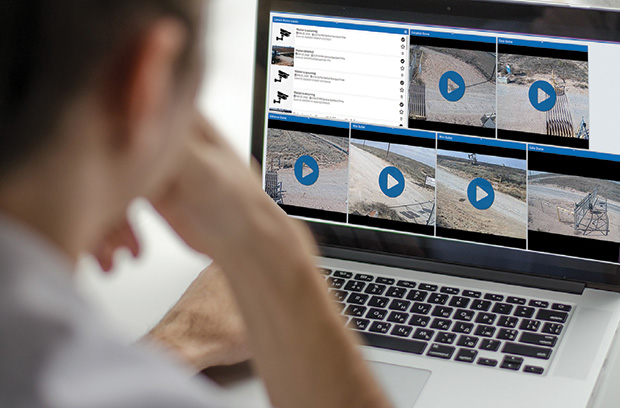
Oil Field Security
Smart Cameras Secure Remote Sites
By Clay Hendon
Site security is challenging for producers, service companies and midstream firms, all of which have vital equipment spread across remote locations. This reality leaves sites vulnerable to damage or theft that can wreak havoc on productivity and disrupt revenue. When criminals strip copper wire from generators or remove tires from trailers, the lost production, downtime and repair costs can be significant.
Others take advantage of poor security to steal oil from storage sites. Vandalism and illegal dumping may have less direct financial impacts, but they create eyesores that can damage a company’s reputation in a way that compromises its ability to work with local communities and investors. Leaks and spills caused by thieves or vandals may have even bigger long-term consequences.
Securing remote sites with cameras, radars and access gates can deter or prevent crime. Advances in solar power and cellular connectivity have made it possible to deploy these systems off grid at a fraction of the cost once required. By leveraging artificial intelligence to analyze the data they collect for anomalies and alerting the right people when those occur, modern devices can eliminate security teams’ need to watch repetitive footage.
This has transformed security teams from sentinels who must have uncommon vigilance to troubleshooters responsible for determining how to respond to trespassers such as thieves or curious cows. These troubleshooters can watch far more sites at once than their predecessors. Coupled with lower device deployment costs, this broad reach has made robust site security affordable enough to be worthwhile even when capital is scarce and budgets tight.
Managing Risk
Like insurance, security systems are about minimizing risks. With strong security, sites are more likely to run smoothly and generate projected revenue. If thefts or vandalism do occur, robust security systems notify the owner quickly enough to minimize the associated downtime and costs.
Conversely, someone with ill intent can access an unprotected site, steal critical equipment and escape without anyone knowing until the equipment needs to be used.
Consider a joint venture operator that oversees several well pads in a rural area. If criminals steal or strip these pads’ generators or pumpjack motors, the operator will need to dispatch technicians to replace or repair them. Insurance may help cover parts and labor, but it is unlikely to compensate for lost production.
Chances are good the impact will continue even after the wells are back on line. Because theft is a known risk, producers may be reluctant to form partnerships with peers that experience frequent downtime associated with poor security.
Weighing Investments
So how much should companies invest in site security, and what form should their security systems take? The answers to those questions depend on the location and the risks the company faces.
At most well pads, cameras and sometimes automated access gates may be enough. For larger sites, such as service company storage yards, radar systems that detect motion and follow it with cameras may be worthwhile. Such radar systems have the advantage of working well even in heavy fog, rain and snow.
As they weigh which sites need to be secured and to what extent, wise companies will consider potential risks rather than focusing solely on problems they have experienced already. For example, producers can face significant liability if a child is injured after trespassing onto a well pad with automated equipment or getting too close to a storage tank that has a faulty thief hatch.
In the long run, more mundane events can disrupt business. If key tools constantly disappear from a work site, workers must waste time chasing down replacements rather than performing the work they are there to do. In such situations, it may be worth installing automated gates to supervise entry points, verify employees’ identities and deter future thefts.
Implementing an automated security system not only will help mitigate the aforementioned risks, but also provide insight into employee and contractor productivity. If progress seems slow given the number of hours worked, the site manager can review surveillance footage or gate access logs to confirm people are working when they say they are and investigate delays.
This type of monitoring also can verify that employees are using work spaces appropriately. One company that implemented a security solution discovered employees had been using a site to conduct personal business and quickly corrected the issue.
Overcoming Barriers to Entry
Because poor site security carries so many risks, most producers, service companies and midstream firms love the idea of remote location monitoring, but in the past, security solutions’ limitations and costs restricted their adoption. However, thanks to modern technologies, remote monitoring is becoming affordable and simple enough to be practical even for small, cash-strapped companies.
Self-contained, solar-powered cameras give operators a security solution for remote sites that is easy to deploy. Thanks to advances in antenna and data compression technology, these cameras can transmit video feeds even when they are in areas that appear to lack connectivity.
One of the biggest barriers to securing remote sites has been powering cameras, radars and access gates. Although it is possible to run power cables from on-site generators to the devices, doing so requires authorization and engineering in areas with footprint standards, as well as time waiting for contractors to dig holes and run cables.
Self-contained cameras that run on solar power can alleviate these concerns. By storing power gathered during sunny days and using on-board processors to manage their power consumption, these devices stay active at night and on cloudy days.
To speed deployment and eliminate the need for digging or other environmental disruptions, these self-contained security systems can be integrated into mobile skids and trailers. With wheels and forklift slots attached to ease transportation, the devices can be moved onto a site quickly, then transported elsewhere once they are no longer needed.
The security system’s footage and other data should be sent to the cloud for on-demand access. With the right antenna and advanced data compression, this is possible even at sites that are miles away from the nearest cellular tower and appear to be in connectivity dead zones.
Monitoring
Once security systems are deployed, they need to be monitored in real time. Instead of looking at footage or access logs only after discovering an issue, companies want to know what is happening as it occurs so they can respond immediately and minimize the negative impacts.
By using artificial intelligence to highlight anomalies in video feeds, modern security platforms allow security professionals to focus on responding to issues rather than watching for them. This increases security systems’ reliability while reducing cost by allowing each professional to monitor several sites.
But monitoring every camera at every site manually is prohibitively expensive (and tedious for the individuals tasked with doing it). This is where edge and cloud computing come into play. When smart cameras detect unusual events, they send footage to the cloud for review by artificial intelligence-based algorithms, which look for discrepancies that deserve human attention and send alerts to appropriate parties.
To be effective, the anomaly detection algorithms need to be sophisticated. If security managers receive alerts and review the footage only to discover swaying branches or cars driving on a nearby highway, they’ll quickly learn to ignore the alerts. But if the algorithms only send notifications when someone hops a fence or fiddles with the gate, the security managers will trust the system enough to open alerts immediately, review the footage and decide what needs to be done.
If the cameras or other parts of the security system include speakers, the response might involve warning trespassers they are being watched. This frequently convinces them to leave.
If trespassers ignore the warning, it’s unlikely anyone will arrive at a remote site before they achieve their goal. Even so, the footage has value, for it can help companies identify which items were stolen or damaged. This saves time by allowing technicians to bring appropriate tools and parts to the site and to focus their inspection on specific areas.
The footage also can be turned over to police and other law enforcement agencies so they can find and prosecute the responsible parties, reducing the chance of future losses.
Even with AI allowing security managers to focus on real incidents, monitoring still can be too demanding for smaller companies that have too few sites to justify hiring a dedicated security manager. In that situation, it often makes sense to partner with third-party security firms who can help the company identify the most cost-effective ways to address their risks, deploy the necessary hardware and take care of monitoring.

CLAY HENDON joined Twenty20 Solutions as director of business development in 2018 and became senior director of operations in 2020. After graduating from the United States Military Academy at West Point with a degree in unconventional warfare, Hendon served as an Infantry officer, leading soldiers through combat in Iraq and Afghanistan. On leaving active duty, he worked for a Dallas-based management consulting firm, where he led public and private companies’ efforts to implement technologies and organizational changes. Next, he was recruited to be the first employee of a global travel security and executive protection startup that now provides bespoke, high-touch security services to Fortune 500 and ultra-high-net-worth clients on six continents.
For other great articles about exploration, drilling, completions and production, subscribe to The American Oil & Gas Reporter and bookmark www.aogr.com.








